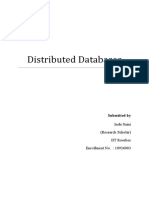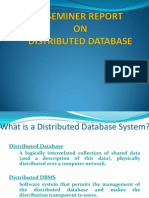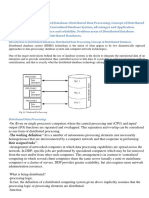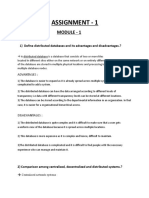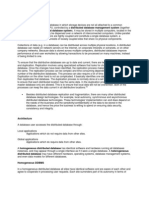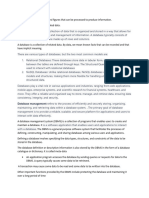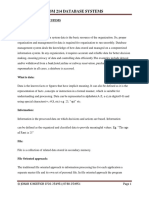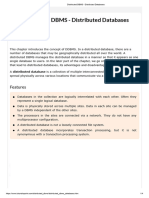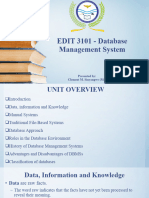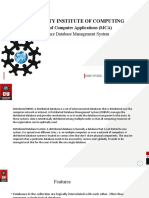Distributed Database Management Systems For Information Management and Access
Distributed Database Management Systems For Information Management and Access
Uploaded by
Vishal VigCopyright:
Available Formats
Distributed Database Management Systems For Information Management and Access
Distributed Database Management Systems For Information Management and Access
Uploaded by
Vishal VigOriginal Title
Copyright
Available Formats
Share this document
Did you find this document useful?
Is this content inappropriate?
Copyright:
Available Formats
Distributed Database Management Systems For Information Management and Access
Distributed Database Management Systems For Information Management and Access
Uploaded by
Vishal VigCopyright:
Available Formats
464
Distributed Database Management Systems for Information Management and Access
N Geetha
Abstract
Libraries play an important role in the academic world by providing access to world-class information resources and services. The explosive growth of Information Technology has paved way to unprecedented phenomenon of access to information. The evolving developments of the recent decades in information access and management have resulted in a situation where information is stored and managed by a large variety of systems around the world. The growing requirements for information support to the globalised socioeconomic forces makes efficient and effective availability of distributed information and correlation of relevant data to the user need. Databases and database systems have become essential components of everyday life in our modern society. In our daily lives, most of us would engage in one activity or another that involves some interaction with a database. This paper discusses the technology used to access and manage the distributed information.
Key words : Database, Database Management System, Distributed Database Management
System, Data Access, Client/Server Systems, Client/Server Architecture.
0.
Introduction
Distributed database technology is one of the most important developments of the past decades. The maturation of database management systems (DBMS) technology has coincided with significant developments in distributed computing results the emergence of Distributed Database Management Systems (DDBMS). Distributed database is a logical database that is physically divided among computers at several sites on a network. A distributed database management system is a database management system capable of supporting and manipulating distributed databases. The distributed database management systems have started to become the dominant management tools for highly intensive applications. The basic motivations for distributed databases are improved performance, increased availability, shareability, expandability and access facility. Computers in a network communicate through messages. Accessing the data using messages over network is slower than the accessing data on disk. In general to access the data rapidly in a distributed databases we must attempt to minimize the numbers of messages. Distributed database management system manages applications based on data access from different sources at multiple locations. As institutions implement networked information strategies which call for sharing and licensing access to information resources in the networked environment. Access management have emerged as major issues, which threaten to impede progress.
1.
Information Access
Information access to the west is much quicker and less dangerous than those days. Todays information highway system had been available to the prospectors of the gold rush. All the data in the enterprise are useless unless they are accessible to the relevant users and processes that can become into knowledge.
2nd International CALIBER-2004, New Delhi, 11-13 February, 2004 INFLIBNET Centre, Ahmedabad
Geetha
465
The distributed database system allows databases to be spread over a network of multiple processors and supports access to those databases by any application running on the network. It also allows distribution of data and applications for faster response time and distributed control and provides communication services across processor nodes.
2.
Distributed Database Management Systems (DDBMS)-Definition
A distributed database is defined as a collection of simple, logically interrelated databases distributed over a computer network. A distributed database management system is then defined as the software system permits the management of the distributed databases and makes this distribution transparency to the users. Distributed database system is to referred as a combination of distributed databases and distributed database management system. The two important terms in these definitions are logically interrelated databases distributed over a computer network.
2.1
Characteristics of Distributed Database Management Systems
A Distributed database management system can be Homogeneous (same local DBMS at each site) or Heterogeneous (different local DBMS). Heterogeneous DBMSs are more complex and more difficult to manage. The DDBMS share the characteristics of location transparency, replication transparency, and fragmentation transparency. Location transparency is the characteristic that states that users do not need to be aware of the location of data in a distributed database. Replications let users at different sites use and update copies of a database and then share their updates with other users. Replication transparency refers to the characteristic that a DDBMS should update various copies of data behind the scenes; users should be unaware of the steps. A Distributed Database Management Systems supports data fragmentation is the DDBMS can divide and manage a logical object, such as records in a table, among the various locations under its control. If users are unaware of fragmentation, the DDBMS has fragmentation transparency.
2.2
Functions of a DDBMS
Application interface Validation to analyze data requests Transformation to determine requests components Query-optimization to find the best access strategy Mapping to determine the data location I/O interface to read or write data Formatting to prepare the data for presentation Security to provide data privacy Backup and recovery DB administration Concurrency control Transaction management
466
Distributed Database Management Systems
S ite 1
S ite 2
D ata ba se
D atab ase
S erver
S erver
N etw o rk
S ite 4 S ite 3
D atab ase
D atab ase
S erver
S erver
Distributed Database Management System (Diagram)
2.3
Rules for Distributed Databases
C.J.Date has formulated 12 rules for Distributed databases. The rules are as follows: 1. Local autonomy - No site should depend on another site to perform its functions. 2. No reliance on a central site - A DDBMS should not need to rely on one site more than any other site. 3. Continuous operation - Performing any function should not shut down the entire distributed database. 4. Location transparency - Users should feel as if the entire database is stored at their location. 5. Fragmentation transparency - Users should feel as if they are using a single central database. 6. Replication transparency - Users should not be aware of any data replication. 7. Distributed query processing - A DDBMS must process queries as rapidly as possible even though the data is distributed. 8. Distributed transaction management - A DDBMS must effectively manage transaction updates at multiple sites. 9. Hardware independence - A DDBMS must be able to run on different types of hardware. 10. Operating system independence - A DDBMS must be able to run on different operating systems. 11. Network independence - A DDBMS must be able to run on different types of networks. 12. DBMS independence - A DDBMS must be heterogeneous.
Geetha
467
2.4
Advantages of Distributed Database Management Systems
Local Autonomy : Since data is distributed, a group of users that commonly share such data can have it placed at the site where they work, and thus have local control. By this way, users have some degree of freedom as accesses can be made independently from the global users. Improved Performance : Data retrieved by a transaction may be stored at a number of sites, making it possible to execute the transaction in parallel. Besides, using several resources in parallel can significantly improve performance. Improved Reliability/Availability : If data is replicated so that it exists at more than one site, a crash of one of the sites, or the failure of a communication line making some of these sites inaccessible, does not necessarily make the data impossible to reach. Furthermore, system crashes or communication failures do not cause total system not operable and distributed DBMS can still provide limited service. Economics : If the data is geographically distributed and the application are related to these data, it may be much more economical, in terms of communication costs, to partition the application and do the processing at each site. On the other hand, the cost of having smaller computing powers at each site is much more less than the cost of having an equivalent power of a single mainframe. Expandibility : Expansion can be easily achieved by adding processing and storage power to the existing network. It may not be possible to have a linear improvement in power but significant changes are still possible. Shareability : If the information is not distributed, it is usually impossible to share data and resources. A distributed database makes this sharing feasible. On the other hand, distribution of the database can cause several problems.
2.5
Disadvantages of Distributed Database Management Systems
Lack of Experience : Some special solutions or prototype systems have not been tested in actual operating environments. More theoretical work is done compared to actual implementations. Complexity : Distributed DBMS problems are more complex than centralized DBMS problems. Cost : Additional hardware for communication mechanisms are needed as well as additional and more complex software may be necessary to solve the technical problems. The trade-off between increased profitability due to more efficient and timely use of information and due to new dataprocessing sites, increased personnel costs has to be analyzed carefully. Distribution of Control : The distribution creates problems of synchronization and coordination as the degree to which individual DBMSs can operate independently. Security : Security can be easily controlled in a central location with the DBMS enforcing the rules. However, in distributed database system, network is involved which it has its own securityrequirements and security control becomes very complicated. Difficulty of Change : All users have to use their legacy data implemented in previous generation systems and it is impossible to rewrite all applications at once. A distributed DBMS should support a graceful transition into a future architecture by allowing old applications for obsolete databases to survive with new applications written in current generation DBMSs.
In spite of the problems and its complexity, the users that will mostly benefit from the distributed DBMSs.
468
Distributed Database Management Systems
2.6
An Example for Distributed Database Management System
2.6.1 Client/Server Systems
The term client/server was first used in the 1980s in reference to personal computers (PCs) on a network. The actual client/server model started gaining acceptance in the late 1980s. The client/server software architecture is a versatile, message-based and modular infrastructure that is intended to improve usability, flexibility, interoperability and scalability. A client is defined as a requester of services and a server is defined as the provider of services. A single machine can be both a client and a server depending on the software configuration. In a network environment, a file server stores files required by users on the network. When users need data from a file, the entire file is sent. In client/server architecture, the server is a computer providing data to the clients, which are the computers that are connected to a network and that people use to access data stored on the server. The DBMS runs on the server and a client sends a request for specific data to the server. Only the necessary data and not the entire file or files are sent. Client/server architecture may be either two-tier or three-tier. In a two-tier architecture, the server performs database functions and the clients perform the presentation (user interface) functions. Either the server or the clients may perform business functions. The term fat client refers to an arrangement where the clients perform the business functions. If the business functions reside on the server, each client is called a thin client. In a three-tier architecture, the clients perform the presentation functions, a database server performs the database functions, and separate computers, called application servers, perform the business functions and act as interface between clients and database server. The advantages to using a client/server system instead of a file server are: lower network traffic; improved processing distribution; thinner clients; greater processing transparency; increased network, hardware, and software transparency; improved security; decreased costs; and increased scalability. Triggers, which are actions that occur automatically in response to associated database operations, provide additional integrity support.
2.6.2 Client/Server Architecture
Client-1
Client-2
Client-3
NETWORK
Server
Database
Geetha
469
3.
Conclusion
Advances in information technology have changed the entire gamut of Library and Information service today. It is time to develop new means of information access and resource sharing with the help of fast growing computer and telecommunication technologies. The libraries serve three roles in learning. They serve practical role in sharing expensive sources both physical and human resource and cultural role in preserving and organizing facts and ideas. Third the libraries serve social and intellectual role by bringing together people and ideas. The Libraries also serve as centers of interdisciplinary places shared by learners from all disciplines. Digital libraries extend such interdisciplinary approach by making diverse information resources available beyond physical space shared by a group of learners. However explosion of data and increased cost of information, force the libraries to work together, and technological advancements acts as platform for accessing and sharing the diversified information. The Library and Information Science profession is preparing for adapting itself to the new environment created by information technology. High performance networks have become key ingredients of competitive scientific research. Research projects especially interdisciplinary ones often require high-speed access to massive data archive and analysis facilities.
4.
References
1. Principles of Database systems by M.T.Ozsu, P.Valduriez. 2. The Push/Pull Effect - Can Distributed, Database Technology Meet The Challenges of New, Applications? Database Programming & Design by M. T. Ozsu. 3. http://www.engr.smu.edu 4. http://www.edtech.uis.edu 5. Proceedings of National Seminar on Information Access, Management and Exchange in the technological age, May 2002. 6. Distributed database systems Bell D
About Author
Mrs. N. Geetha is Assistant Librarian at Anna University, Chennai-600 025, India. She holds Masters in Zoology, LIS and undergone training in British Council Library, Chennai. E-mail : geethkowsalya@hotmail.com, aulib@annauniv.edu
You might also like
- David Nicholas - The Evolution of The Medieval World (2014, Routledge) - Libgen - LiDocument561 pagesDavid Nicholas - The Evolution of The Medieval World (2014, Routledge) - Libgen - LiLuis MartinsNo ratings yet
- Oxford Press and Politics in The Weimar Republic PDFDocument343 pagesOxford Press and Politics in The Weimar Republic PDFMaria Sosa100% (1)
- Distibuted Database Management System NotesDocument58 pagesDistibuted Database Management System NotesSonu MalikNo ratings yet
- Flora and Ulysses Teachers' GuideDocument4 pagesFlora and Ulysses Teachers' GuideCandlewick Press100% (4)
- Feature of Distributed DatabaseDocument28 pagesFeature of Distributed DatabasevirushilalNo ratings yet
- Distributed Databases: Indu Saini (Research Scholar) IIT Roorkee Enrollment No.: 10926003Document14 pagesDistributed Databases: Indu Saini (Research Scholar) IIT Roorkee Enrollment No.: 10926003Indu SainiNo ratings yet
- DDBS Lec1Document20 pagesDDBS Lec1manassarker akashNo ratings yet
- Distributed Databases IntroductionDocument16 pagesDistributed Databases IntroductionTirth Nisar100% (1)
- Distributed DatabasesDocument26 pagesDistributed DatabasesHalim Maulana L100% (1)
- Distributed Database: Database Database Management System Storage Devices CPU Computers NetworkDocument15 pagesDistributed Database: Database Database Management System Storage Devices CPU Computers NetworkInderjeet BalNo ratings yet
- DbmsDocument7 pagesDbmshelenxiaochingNo ratings yet
- Answer Question 8 Assignment AaDocument6 pagesAnswer Question 8 Assignment AajhghjgjhgNo ratings yet
- Distributed Database OverviewDocument5 pagesDistributed Database OverviewFuzzy0neNo ratings yet
- Distributed DBDocument4 pagesDistributed DBNidhi BharatiyaNo ratings yet
- Distributed DatabaseDocument24 pagesDistributed DatabaseHimashree BhuyanNo ratings yet
- Unit 4 DBMSDocument15 pagesUnit 4 DBMSsrnarayanan_slmNo ratings yet
- Distributed DBDocument43 pagesDistributed DBGopal GargNo ratings yet
- Module 1Document24 pagesModule 1RAMYA KANAGARAJ AutoNo ratings yet
- CSC457 DOOD - ClassnotesDocument113 pagesCSC457 DOOD - ClassnotesPrabin SilwalNo ratings yet
- 14 Distributed DBMSsDocument14 pages14 Distributed DBMSsANDFAN DAKANo ratings yet
- Unit 2 DDMSDocument26 pagesUnit 2 DDMSvashu150105No ratings yet
- Module 1 - ELECTIVE 1Document11 pagesModule 1 - ELECTIVE 1group.four.it2r7No ratings yet
- Distributed Database: SourceDocument19 pagesDistributed Database: SourcePro rushoNo ratings yet
- ADBMS Presentation_new.pptcollageDocument5 pagesADBMS Presentation_new.pptcollagerameshwarip.mca2024No ratings yet
- Distributed Database SystemDocument15 pagesDistributed Database Systemwater khanNo ratings yet
- DDB.NOTESDocument19 pagesDDB.NOTESjameelsultan.cse.ggi.2020No ratings yet
- Ddbms AssignmentDocument7 pagesDdbms AssignmentHarsh MahtoNo ratings yet
- Question No 1 DDBMS Advantages and Disadvantage:: ExampleDocument3 pagesQuestion No 1 DDBMS Advantages and Disadvantage:: Examplemuzamil shabirNo ratings yet
- Cs9152 DBT Unit I NotesDocument53 pagesCs9152 DBT Unit I NotesHema Latha100% (1)
- DISTRIBUTED DATABASEDocument11 pagesDISTRIBUTED DATABASEabbashaider786000No ratings yet
- Distributed Database Vs Conventional DatabaseDocument4 pagesDistributed Database Vs Conventional Databasecptsankar50% (2)
- System Admin and Server IntegrationDocument3 pagesSystem Admin and Server Integrationmanoj22490No ratings yet
- Cosc 305Document15 pagesCosc 305abubakarumarfarouq667No ratings yet
- DDBSDocument19 pagesDDBSBudhaditya MukherjeeNo ratings yet
- Unit 13 Distributed Database: StructureDocument10 pagesUnit 13 Distributed Database: StructuregaardiNo ratings yet
- Parallal DatabasesDocument4 pagesParallal DatabasesthirupathinNo ratings yet
- COMP 214 DATABASE SYSTEMS NOTES PDF Sem 1 2019 PDFDocument47 pagesCOMP 214 DATABASE SYSTEMS NOTES PDF Sem 1 2019 PDFVictor Kirui50% (2)
- 05 Unit5Document22 pages05 Unit5Inder DialaniNo ratings yet
- DIT 0201-HCT0104-Database NotesDocument37 pagesDIT 0201-HCT0104-Database NotesISAACNo ratings yet
- DDB LecturesDocument21 pagesDDB Lectureshassan313.g4lNo ratings yet
- Distributed DatabaseDocument9 pagesDistributed DatabaseJane hiramNo ratings yet
- Question Bank SolvedDocument11 pagesQuestion Bank SolvedVishv FalduNo ratings yet
- DDB-distribution Database Important.Document15 pagesDDB-distribution Database Important.Aman PaidlewarNo ratings yet
- Distributed DatabasesDocument39 pagesDistributed DatabasesKandiga ParandhamanNo ratings yet
- Distributed DBMS - Distributed DatabasesDocument4 pagesDistributed DBMS - Distributed DatabasesHemavathiNo ratings yet
- RDBMS Unit-5Document32 pagesRDBMS Unit-5kevanaccNo ratings yet
- Topic 1 Msbte Questions and AnswersDocument14 pagesTopic 1 Msbte Questions and Answerssaee7390No ratings yet
- Cs9152 Unit IDocument52 pagesCs9152 Unit IThirumalaiNo ratings yet
- EDIT 3101 - Database Management System - Lecture 1Document29 pagesEDIT 3101 - Database Management System - Lecture 1sichingadavies84No ratings yet
- Class: 12 Subject: Computer Science Chapter: Relational Databases Topic: Database Assignment: 1Document2 pagesClass: 12 Subject: Computer Science Chapter: Relational Databases Topic: Database Assignment: 1ayush6307446201No ratings yet
- University Institute of Computing: Master of Computer Applications (MCA)Document8 pagesUniversity Institute of Computing: Master of Computer Applications (MCA)Rohit DahiyaNo ratings yet
- DDS Lecture 2Document38 pagesDDS Lecture 2SajjadAbdullah0% (1)
- Advantages and Extra Functions of DistributedDocument3 pagesAdvantages and Extra Functions of DistributedkamalshrishNo ratings yet
- ADBMS Notes 3Document9 pagesADBMS Notes 3dipashachaturvediNo ratings yet
- Dbms Assignment-2Document12 pagesDbms Assignment-2Bharat MalikNo ratings yet
- Distributed DBDocument16 pagesDistributed DBArchana SaravananNo ratings yet
- Distributed Database Systems (DDBS)Document30 pagesDistributed Database Systems (DDBS)Muhammad Usman YounasNo ratings yet
- ADBMS PresentationDocument5 pagesADBMS Presentationdeshmukhvishakha2003No ratings yet
- Chapter 2 - Hardware and Software Concepts: 2004 Deitel & Associates, Inc. All Rights ReservedDocument41 pagesChapter 2 - Hardware and Software Concepts: 2004 Deitel & Associates, Inc. All Rights ReservedVishal VigNo ratings yet
- Comparison of Aodv and DSR Manet Routing Protocols: Presented By: Sandeep Kaur Mtech CSE/ Part Time Roll No: M10/12Document9 pagesComparison of Aodv and DSR Manet Routing Protocols: Presented By: Sandeep Kaur Mtech CSE/ Part Time Roll No: M10/12Vishal VigNo ratings yet
- E CommerceDocument323 pagesE CommerceSuresh Kumar80% (15)
- Risk Management: Nitesh Kumar, Asst. Professor, LPUDocument14 pagesRisk Management: Nitesh Kumar, Asst. Professor, LPUVishal VigNo ratings yet
- Event Notification 1Document15 pagesEvent Notification 1Vishal VigNo ratings yet
- SPM Lect1 and Lect2Document17 pagesSPM Lect1 and Lect2Vishal VigNo ratings yet
- Lovely Professional University: Submitted ByDocument12 pagesLovely Professional University: Submitted ByVishal VigNo ratings yet
- Works of Arts of Filipino Artist: Prepared By: Precious Grace A. Salazar BSA2.1Document16 pagesWorks of Arts of Filipino Artist: Prepared By: Precious Grace A. Salazar BSA2.1Dong RoselloNo ratings yet
- Immediate download German for Reading Knowledge (World Languages) – Ebook PDF Version ebooks 2024Document51 pagesImmediate download German for Reading Knowledge (World Languages) – Ebook PDF Version ebooks 2024anderwannida100% (4)
- Brown Et Al. (2015) Searchable Objects: Search in Everyday ConversationDocument10 pagesBrown Et Al. (2015) Searchable Objects: Search in Everyday ConversationDavid MonteiroNo ratings yet
- Library DesignDocument1 pageLibrary DesignRens_Davis_8183No ratings yet
- Como Instalar Modulos Perl en Active Perl de Active StateDocument3 pagesComo Instalar Modulos Perl en Active Perl de Active StatejorginmxNo ratings yet
- Review of Late Roman Army in SerbiaDocument57 pagesReview of Late Roman Army in Serbiadcslazar7No ratings yet
- Zaha HadidDocument4 pagesZaha HadidRohit_Bhutada_3047No ratings yet
- Soña Holman: Pump Project Art ComplexDocument3 pagesSoña Holman: Pump Project Art ComplexSoña HolmanNo ratings yet
- Lecture On Post-War Japanese PhotographyDocument15 pagesLecture On Post-War Japanese PhotographyMika Kobayashi100% (2)
- On The Future of Conservation BiologyDocument4 pagesOn The Future of Conservation BiologynephilaNo ratings yet
- Impressionism Vs Expressionism: by Daisy MariposaDocument4 pagesImpressionism Vs Expressionism: by Daisy MariposaMaria Fe VibarNo ratings yet
- Sat Practice Test 2 Writing and Language Assistive TechnologyDocument88 pagesSat Practice Test 2 Writing and Language Assistive TechnologyAgungdeAngeloNo ratings yet
- Bibliometric LawsDocument35 pagesBibliometric LawssonyNo ratings yet
- Dark Rooms by Lili Anolik - ExtractDocument17 pagesDark Rooms by Lili Anolik - ExtractAnonymous ikUR753amNo ratings yet
- Practical File For CDocument68 pagesPractical File For CNarayan VermaNo ratings yet
- Unit 4 - IELTS WritingDocument10 pagesUnit 4 - IELTS WritingEva Chen100% (1)
- ReadmeDocument6 pagesReadmeBalconi BccNo ratings yet
- Block StatueDocument9 pagesBlock StatueAhmed MansourNo ratings yet
- History of National BookstoreDocument8 pagesHistory of National BookstoreWarren De LunaNo ratings yet
- La Cabale MagicochimiqueDocument282 pagesLa Cabale MagicochimiquesonyanoNo ratings yet
- 3 Contemporary Art WorldDocument3 pages3 Contemporary Art WorldValen AguirreNo ratings yet
- Engineering Philosophy of Ancient IndiaDocument36 pagesEngineering Philosophy of Ancient IndiaAshok NeneNo ratings yet
- Master Drawings AssociationDocument29 pagesMaster Drawings AssociationMau OviedoNo ratings yet
- Download ebooks file Black Populism in the United States An Annotated Bibliography Bibliographies and Indexes in Afro American and African Studies Anthony J. Adam all chaptersDocument60 pagesDownload ebooks file Black Populism in the United States An Annotated Bibliography Bibliographies and Indexes in Afro American and African Studies Anthony J. Adam all chaptersarneynezaj9a100% (12)
- Jain Tamilian LabourDocument8 pagesJain Tamilian LabourAmal SyaNo ratings yet
- Rank The 10 Best and Most Fascinating Zoos in The WorldDocument12 pagesRank The 10 Best and Most Fascinating Zoos in The WorldTey ValenzuelaNo ratings yet
- 11-20 Virtvs Avgvstorvm Margetic enDocument10 pages11-20 Virtvs Avgvstorvm Margetic enDavor MargeticNo ratings yet





